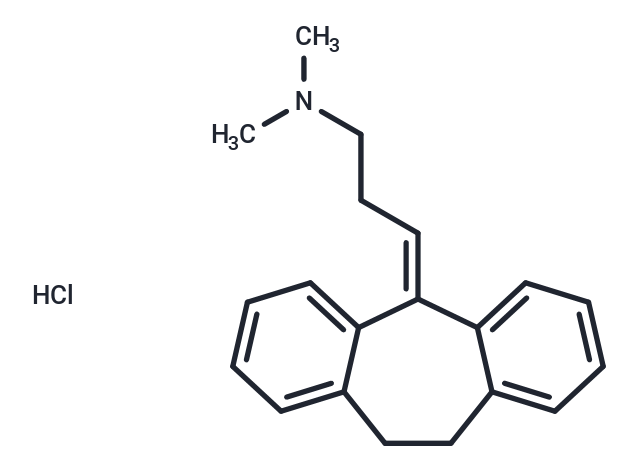Shopping Cart
- Remove All
 Your shopping cart is currently empty
Your shopping cart is currently empty

Amitriptyline hydrochloride (Annoyltin) is the hydrochloride salt of the tricyclic dibenzocycloheptadiene amitriptyline with antidepressant and antinociceptive activities.

| Pack Size | Price | Availability | Quantity |
|---|---|---|---|
| 500 mg | $45 | In Stock | |
| 1 g | $53 | In Stock |
| Description | Amitriptyline hydrochloride (Annoyltin) is the hydrochloride salt of the tricyclic dibenzocycloheptadiene amitriptyline with antidepressant and antinociceptive activities. |
| Targets&IC50 | 5-HT receptor:3.45 nM, 5-HT4:7.31 nM, Norepinephrine receptor:13.3 nM, σ1 receptor:287 nM, 5-HT2:235 nM |
| In vitro | Amitriptyline inhibits Forskolin-stimulated cyclic AMP accumulation with EC50 values of 16.2 μM in intact CHO/DOR cells. Amitriptyline causes a concentration-dependent stimulation of ERK1/2 and GSK-3β phosphorylation with EC50 values of 9.0 μM in CHO/DOR cells. Amitriptyline (15 μM) causes a stimulation of ERK1/2 phosphorylation in C6 cells. Amitriptyline (30 μM) inhibits Forskolin-stimulated adenylyl cyclase activity and antagonizes ( )-U50,488 inhibitory effect in rat nucleus accumbens. [5] Amitriptyline binds the extracellular domain of both TrkA and TrkB and promotes TrkA-TrkB receptor heterodimerization. Amitriptyline (< 500 nM) promotes TrkA autophosphorylation in primary neurons and induces neurite outgrowth in PC12 cells. Amitriptyline selectively protects T17 cells from apoptosis with EC50 of 50 nM. [6] |
| In vivo | Amitriptyline (15 mg/kg, i.p.) activates TrkA and TrkB receptors and significantly reduces kainic acid-triggered neuronal cell death in mice. [6] Amitriptyline (15 mg/kg and 30 mg/kg, i.p.) dose-dependently decreases the immobility time in the forced swimming test (FST) of mice. Amitriptyline (15 mg/kg, i.p.) shows a significant 24-h rhythm in the immobility time in the forced swimming test (FST) of mice. [7] Amitriptyline (1 mg/kg and 3 mg/kg) significantly increases the total distance travelled of mice in novel cages. Amitriptyline (10 mg/kg p.o., twice daily) considerably attenuates the hypothermic response to 8-OHDPAT and mCPP in mice. Amitriptyline (10 mg/kg p.o., twice daily) significantly reduces serotonin transporter density by approximately 20% in cortex of mice. [8] |
| Alias | Tryptizol, Domical, Annoyltin, Amitriptyline HCl |
| Molecular Weight | 313.86 |
| Formula | C20H24ClN |
| Cas No. | 549-18-8 |
| Smiles | Cl.CN(C)CC\C=C1\c2ccccc2CCc2ccccc12 |
| Relative Density. | 1.076g/cm3 |
| Storage | Powder: -20°C for 3 years | In solvent: -80°C for 1 year | Shipping with blue ice. | ||||||||||||||||||||||||||||||||||||||||
| Solubility Information | DMSO: 50 mg/mL (159.31 mM), Sonication is recommended. H2O: 12 mg/mL (38.23 mM), Sonication is recommended. Ethanol: 59 mg/mL (187.98 mM), Sonication is recommended. | ||||||||||||||||||||||||||||||||||||||||
Solution Preparation Table | |||||||||||||||||||||||||||||||||||||||||
H2O/DMSO/Ethanol
DMSO/Ethanol
| |||||||||||||||||||||||||||||||||||||||||

Copyright © 2015-2025 TargetMol Chemicals Inc. All Rights Reserved.